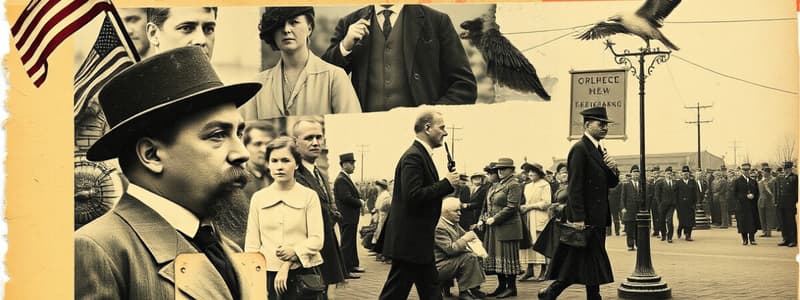Podcast
Questions and Answers
What are nativists?
What are nativists?
Americans and others who opposed immigration
What was the Know-Nothing Party?
What was the Know-Nothing Party?
A political organization founded in 1849 by the Nativists that supported measures making it difficult for foreigners to become citizens and hold office.
Define middle-class.
Define middle-class.
A social and economic level between the wealthy and the poor
What were the rules of baseball?
What were the rules of baseball?
What are tenements?
What are tenements?
What is transcendentalism?
What is transcendentalism?
Who was Ralph Waldo Emerson?
Who was Ralph Waldo Emerson?
Who was Henry David Thoreau?
Who was Henry David Thoreau?
What are Utopian communities?
What are Utopian communities?
Who wrote The Scarlet Letter?
Who wrote The Scarlet Letter?
Who became famous for the poem called 'The Raven'?
Who became famous for the poem called 'The Raven'?
What is the title of the famous poem written by Henry Wadsworth Longfellow?
What is the title of the famous poem written by Henry Wadsworth Longfellow?
Who wrote the novel Little Women?
Who wrote the novel Little Women?
What was the Second Great Awakening?
What was the Second Great Awakening?
Who was Charles Grandison Finney?
Who was Charles Grandison Finney?
What was the Temperance Movement?
What was the Temperance Movement?
Who was Dorthea Dix?
Who was Dorthea Dix?
What was the Common-School Movement?
What was the Common-School Movement?
Who was Horace Mann?
Who was Horace Mann?
What did Catharine Beecher do?
What did Catharine Beecher do?
What was the Troy Female Seminary?
What was the Troy Female Seminary?
Who was Thomas Gallaudet?
Who was Thomas Gallaudet?
Where did Free African Americans usually live?
Where did Free African Americans usually live?
What were slaveholders fearful of?
What were slaveholders fearful of?
What does abolition mean?
What does abolition mean?
What was Liberia?
What was Liberia?
Who published an abolitionist newspaper called The Liberator?
Who published an abolitionist newspaper called The Liberator?
What was the American Anti-Slavery Society?
What was the American Anti-Slavery Society?
Who were Angelina and Sarah Grimke?
Who were Angelina and Sarah Grimke?
Who was Frederick Douglass?
Who was Frederick Douglass?
What did Sojourner Truth proclaim?
What did Sojourner Truth proclaim?
What was the Underground Railroad?
What was the Underground Railroad?
Who was Harriet Tubman?
Who was Harriet Tubman?
What are bounty hunters known for?
What are bounty hunters known for?
What did women's rights activists find unacceptable?
What did women's rights activists find unacceptable?
What was the Seneca Falls Convention?
What was the Seneca Falls Convention?
What is the Declaration of Sentiments?
What is the Declaration of Sentiments?
Who was Lucy Stone?
Who was Lucy Stone?
Who was Susan B. Anthony?
Who was Susan B. Anthony?
Who helped organize the Seneca Falls Convention?
Who helped organize the Seneca Falls Convention?
How many immigrants crossed the Atlantic Ocean to settle in the United States?
How many immigrants crossed the Atlantic Ocean to settle in the United States?
Where were most immigrants from during the mid-1800s?
Where were most immigrants from during the mid-1800s?
Why did some Germans immigrate to the United States?
Why did some Germans immigrate to the United States?
What did the United States offer to immigrants?
What did the United States offer to immigrants?
Study Notes
Nativism and Political Movements
- Nativists opposed immigration, advocating for policies that favored native-born citizens.
- The Know-Nothing Party, founded in 1849, sought to restrict foreign-born individuals from gaining citizenship or holding office.
Social Structures and Living Conditions
- The middle class emerged as a distinct social group situated between the wealthy and the poor.
- Tenements were poorly designed and overcrowded apartment buildings, often unsanitary and unsafe for residents.
Cultural Developments
- Baseball's rules were formalized in 1845, contributing to the sport's popularity in America.
- Transcendentalism promoted the idea of rising above material concerns, emphasizing individualism and self-reliance.
Influential Thinkers and Writers
- Ralph Waldo Emerson encouraged Americans to prioritize personal beliefs over societal institutions.
- Henry David Thoreau's work, WALDEN, reflected his advocacy for simple living in harmony with nature.
- Nathaniel Hawthorne's The Scarlet Letter explored the complexities of Puritan life.
- Edgar Allan Poe gained fame for his poem "The Raven," embodying themes of dark romanticism.
- Henry Wadsworth Longfellow is noted for "The Midnight Ride of Paul Revere," celebrating American history.
- Louisa May Alcott authored Little Women, detailing the lives of four sisters pre-Civil War.
Religious Movements
- The Second Great Awakening was a Christian revival movement that influenced many Americans in the late 18th and early 19th centuries.
- Charles Grandison Finney emerged as a significant leader during this religious revival.
Reform Movements
- The Temperance movement aimed to reduce alcohol consumption through self-discipline.
- Dorthea Dix advocated for the rights of the mentally ill, leading to the establishment of over 100 state hospitals.
Education Reforms
- The Common-School Movement sought to provide universal education regardless of background.
- Horace Mann was a key figure in advocating for free public education, while Catharine Beecher founded an all-female academy in Connecticut.
- Emma Willard established the Troy Female Seminary, the first college-level institution for women.
- Thomas Gallaudet played a vital role in improving education for the hearing impaired, founding a free school in 1817.
African American Experiences
- Free African Americans primarily lived in segregated communities in Northern cities like New York and Boston.
- Slaveholders feared that education could incite revolts among enslaved African Americans.
- Abolition represented the total cessation of slavery, with Liberia established in 1822 as a colony for freed African Americans.
Abolitionist Movement
- William Lloyd Garrison founded The Liberator, an influential abolitionist newspaper, in 1831.
- The American Anti-Slavery Society, established by Garrison in 1833, called for immediate emancipation and racial equality.
- Angelina and Sarah Grimke were prominent white southern anti-slavery activists, with Angelica publishing impactful pamphlets.
- Frederick Douglass became a leading African American figure, advocating for abolition and women's rights after his escape from slavery.
- Sojourner Truth became known for her powerful speeches promoting anti-slavery and women's rights.
Underground Railroad
- The Underground Railroad was a secret network assisting escaped slaves in reaching freedom.
- Harriet Tubman was a notable conductor on the Underground Railroad, having freed many slaves after her own escape.
Women's Rights Movement
- Women's rights activists fought against social injustices, including lack of voting rights and property control.
- The Seneca Falls Convention marked the first organized meeting for women's rights in the U.S.
- The Declaration of Sentiments was a foundational document outlining grievances against societal norms.
Key Figures in Women's Rights
- Lucy Stone was an outspoken advocate for both abolition and women's rights.
- Susan B. Anthony worked to politicize the movement, emphasizing equal rights in pay and property law.
- Elizabeth Cady Stanton was instrumental in organizing the Seneca Falls Convention and co-authored the Declaration of Sentiments.
Immigration Patterns
- Over 4 million immigrants arrived in the U.S. in the mid-19th century, largely from Ireland and Germany.
- Irish immigrants, fleeing the 1840s potato blight, faced starvation and disease, with over a million fatalities.
- German immigrants sought refuge from political unrest and oppression, primarily coming for economic opportunities.
Studying That Suits You
Use AI to generate personalized quizzes and flashcards to suit your learning preferences.
Description
Test your knowledge of key terms from American History Chapter 14 with these flashcards. Explore important concepts such as nativism, the Know-Nothing Party, and the social dynamics of the middle class. Ideal for students looking to strengthen their understanding of this significant period in U.S. history.




